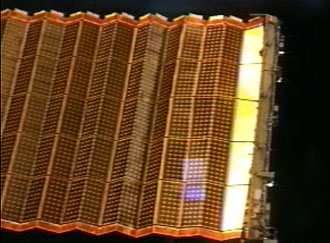The retirement of the solar collectors will allow them to be connected tomorrow by spacewalk to the station's electrical system

The first step towards the challenging work expected tomorrow for STS-116 crew members will be to rewire the power cables on board the International Space Station, was carried out today (D) when the left wing of the two solar collectors attached to the station's P6 component slowly began to separate. The retirement began at 13:28 EST (20:38 Israel time).
The retirement of the long solar collectors (about 35 meters long) that were rolled up in NASA warehouses for over six years, will enable the engine located in the P4 component to be activated. The engine, known as Alpha Rotary Joint, or SARJ for short, will allow the component to track the sun while the rapid movement of the station creates alternating sunsets and sunrises in a cycle of one and a half hours. The SARJ launch was scheduled for 21:57 p.m.
Two spacewalks will be required during the STS-116 mission to rewire and reconnect the station's power distribution. Once the control personnel confirm that the system is tracking the sun, the astronauts will begin preparations for the second spacewalk, scheduled for 22:12 p.m. on Thursday. Astronauts Bob Korbim and Christer Vogelsang, who performed the first spacewalk yesterday, will also perform Thursday's spacewalk.
The two again went for a field stay in the station's airlock to prepare for the spacewalk, lowering the air pressure to that of ten thousand feet above sea level. The process is designed to prevent the danger of decompression sickness when the two will experience even lower air pressure in the space suits, when outside.
Another activity carried out by the members of the two teams was giving interviews to the CBS and Fox radio networks.
